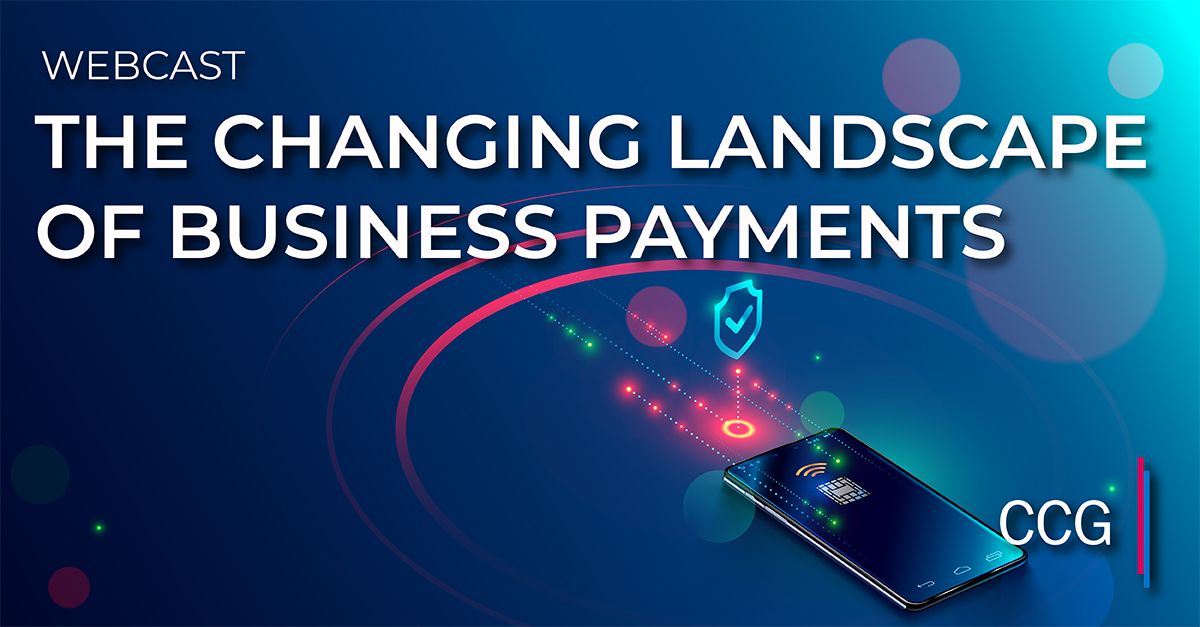The Changing Landscape of Business Payments
Available On Demand – 22 minutes
The payments landscape is changing faster than ever before with new entrants entering the market on a consistent basis. It is imperative for banks and credit unions to understand and adopt to new innovations like digital payment functionality to stay competitive. This is not only important for customers and their experiences but also for financial institutions so they can optimize internal operations. What is your payment strategy and how does this impact your business clients? Tune into CCG’s Webcast series with host Scarlett Sieber and industry veterans Joe Spatarella and John Macaluso to find out why efficient business payment strategies are important.
Subscribe to CCG Insights.
[restrict]
Scarlett Sieber Welcome back to our CCG webcast series. We are back for another great week of engaging content. This week we are going to be looking at the changing landscape of business payments. A few weeks prior, we talked and got a little introductory conversation into payments with my colleague John Macaluso. This week, we’re coming back with the business payments aspect. And I have two great colleagues with you today. I have Joe Spatarella, who is Managing Director here at CCG, and John Macaluso, Principal here at CCG. As always, I am your host, Scarlett Sieber, Chief Strategy Innovation Officer here at CCG. You got the whole crew here with you. We’re going to be diving into another topic that we definitely enjoy talking about amongst ourselves and we hope you enjoy it as well. As you remember, we try to keep these conversations short, simple, concise, 15 minutes, give you a lot of content and information and then you can go back to your day. We know you have busy lives. So very quickly, let’s go over some housekeeping rules right below your screen. You will see a picture with our faces. That is our bios and backgrounds. You can click on the arrow below that. You will see our full bios. You can connect with us on any of our social channels. We post a lot of content out there. It might be helpful for you to go follow us there. You can also connect with us directly on our emails. And to the right of that you have the CCG logo. That is your go to resource place for all things CCG and beyond. We do a lot of writing. We do a lot of speaking. All of those resources are there. There are some latest and greatest articles for you to access there, as well as our future webcasts are going to be listed there as well. So, you can see what we have going on. To the left, you have the Q and A button. That is for you to use at your disposal throughout this conversation. If you have questions, please send them over to us. We will do our best to answer while live on the webcast. Because this is a short and simple format, we don’t get to answer too many of your questions, but please do send them over. We will answer as many as we can, and if not, we will get back to you directly after the webcast. All right. Housekeeping is out of the way. Looking forward to getting this conversation. Joe, Mac, happy to have you both here. Thank you for joining us today.
Joe & Mac Great. Thanks, Scarlett.
Scarlett Sieber All right, so we are the Three Musketeers, I’ve decided. The ones who are leading this webcast and so it’s great to be doing this with both of you at the same time as we usually do two separate ones. But let’s get started here. I want you to explain to the group why we want to focus on business payments and explain why these are different from the current consumer payment conversation that we’ve been having.
John Macaluso So I’ll take that and start and then we’ll get Joe’s perspective. But so to be fair, payments are a critical conversation that everybody should be having. And we talk about it all the time internally. In fact, we have some articles coming out on it here shortly. But the real opportunity in payments is critical. The opportunity in payments for banks and credit unions is driving business payments. And the big difference between the two is how comfortable we are in managing risk. Obviously, consumer payments are for generally lesser dollar amounts. Business payments are for larger dollar amounts. Facilities are in place for checks and for card payments that allow for a clawback of those if they’re done by mistake or in error. However, when you start to put that on the business side, the dollar amounts become so large that banks and credit unions have historically shied away from making any real big changes around business payments. The challenge there is that our customers are now demanding that we start to look at new and innovative ways of making business payments, very much like what is happening on the consumer side.
Joe Spatarella I think the whole landscape is really changing in that there are other ways than the traditional. What we had in the past was the ability to send a wire if you needed to get there fast and were willing to pay more money for it. You can use any CH or a check if time was not that important and you did not want the cost to be that high. Now we are looking at things like real time payments and virtual purchase cards. In general, there are a lot more vehicles for moving money than there used to be. And in the midst of this pandemic, there’s definitely a new emphasis on contactless payments. For example, I go to the grocery store and pay with my app as opposed to exchanging cash or a debit card with the cashier. I think the opportunity is there in general to make all this a lot more consumable by the business, meaning that we want to break down the barriers between the different silos. It should not matter what payment method they use. What should matter is how much they are sending, how fast is it going to get there and how much they are willing to pay to get there. Pretty much like a shipping label if you consider that comparison.
Scarlett Sieber Thanks for that, Joe. I think there is certainly a lot of opportunities. You alluded to some of them just now. If I’m putting on my bank CEO hat, what are some key areas for bank executives like myself as a CEO to start considering when we’re thinking about creating this business payment strategy? Because I feel like a lot of times, we end up being reactive and kind of getting what comes with the package from a vendor or whatever else. So, if I’m being very intentional about putting this in my strategy, what are some things I should be thinking about from a business payments perspective?
Joe Spatarella There are a number of key issues that a lot of folks are wrestling with right now. One of them is do they adopt and make the move to real time payments? And we can talk a little bit more about that. But real time payments provide an alternative to wire transfers for immediate funds and funds that are not subject to settlement. They can be done 24 hours a day, seven days a week, 365 days a year. They can carry invoice information along with them. It lends itself to a lot of B2B ecommerce. Another thing to consider is whether or not to deploy a payments hub that would bring together the traditional. Again, a CH or wire payment method along with things like real time payments and even international or global payments based on the client base that they’re supporting. And in general, finding a way to have more efficiency in the processing and in the risk management and even being able to provide through a payment hub, you know, least cost processing or most efficient routing of transactions through any number of payment vehicles. It really speaks to a longer-term payment strategy that should be a reflection of each institution’s clients and their specific business needs in terms of what they’re trying to accomplish. Is it domestic only? Is it domestic and international? Is it multi-currency? Is there a lot of demand for carrying invoice remittance information and integrating with various financial accounting systems and the like? I think those are some of the key areas.
Scarlett Sieber I appreciate that. Mac, I’m curious. Same question, I am the bank CEO and I have my hat on. As I’m contemplating and anticipating my strategy moving forward, how does what Joe outlined and defined differ when we’re looking at it from the consumer perspective?
John Macaluso So actually, Scarlett, they’re not very different technically. We’re actually utilizing the same rails on the consumer side that we would use on the business side, so whether we’re using the ACH rails or we’re doing a wire or we’re using the debit rails. The reality is that they’re not very different. Now the key here, and Joe hit it and I think we’re going to talk more about this later, is when you start to apply real time, many more factors come into play. There is tremendous opportunity on the consumer side. I can make an immediate payment. I can get credit for that payment. I can take care of that on the business side. I can make an immediate payment. I can make those funds available. I can get the goods, as I said earlier. And the reality is it is very, very beneficial to me. However, there is much more risk involved. And this is where banks need to truly understand their customers. And the point that Joe made a few minutes ago as to, hey, what are my requirements? Do I send invoice information? What are the clawback possibilities? Truly understanding my customer and applying that understanding to how you implement a payment strategy is critical here. I see many customers. What they’re really doing is they’re taking payment hubs, as Joe said, and they’re throwing these into kind of clean up the ugliness that has evolved in money movement and payment processing. So to answer your question specifically, there really isn’t technically a big difference between the two. It’s our comfort as an industry on how we want to manage the risk. That is the key.
Scarlett Sieber Got it. I do want to interject for one second if I can, because we have a question that I think is timely based off of what we’re speaking about. So Sean asks if you could limit it to one thing, what would be the biggest opportunity for business payments that you both see?
Joe Spatarella Well, I think from my perspective, it’s real time payments because again, it is a great alternative to wire transfers. It is immediate. It is unconditional funds. They are not subject to settlement. I think the pricing will vary institution by institution. But, the general assumption it will be more than ACH, but less than a wire and maybe less by 50 percent. And it lends itself to B2B business transactions. I think adopting that that additional new payment method is significant.
John Macaluso Real time payments are a game changer. It truly is. For 60 years, we have managed with these rails that are fundamentally bash rails. And we’ve built all these systems around them and we have created limitations. And we’ve created a whole vernacular around these things. For example, our customers can tell us what an RTN number is, which is ridiculous that customers should know so much about the banking system. Real time payments can absolutely change the game. It can mitigate a lot of the issues that we have in how we exchange money. Unfortunately, with that comes some concerns. One of the things right off the top of my head, I will tell you, while, RTP is great, one of the first things that you are told when you join that is there are no clawback provisions. When that money exits, that money exits. It’s much like in wires when that money exits because of the immediate settlement, all the money is moved. And guess what? You’re not getting it back. So, know your end point. Know who you’re paying. Understand that and make sure that you’re happy in the transaction before you make that payment. But other than that, I’m very much a fan. And we here at CCG believe strongly in that RTP as a chance to dynamically change business payments.
Scarlett Sieber Thank you, Sean, for that. There is a lot here to think about as you’re building out that strategy. If we could be a little bit more specific and direct, what is the call to action for community banks and credit unions who want to enhance their payment strategy? What is that? What does that entail? And really, can you identify any enhancements or gaps that you think that these smaller financial institutions are uniquely qualified to fill?
Joe Spatarella I think I can address that. A lot of times the payment systems are viewed more from an operational perspective, not so much from a customer perspective, meaning that they may be using Fed Advantage Terminals, where they’re at the level of automations, very limited and all of the balance checking and credit checking into like all manual processes or they may have a lower ends, you know, wire or an ACH processing system that’s limited capability. Or it’s just one where their volume has just outpaced what that particular system can handle. There is an operational consideration and there’s a technology consideration there. And then there’s the customer piece of it. But you don’t really sell payments. People need to make them or they don’t and winning business is really about making it easy for them to do. Making sure that they send it receives the kind of affirmation they need. And I think that what we’re seeing a lot of it in the market that there are new products to support integrated payables where a company can take a payables file right out of their financial accounting system or ERP system and send that to a bank or a credit union and then they can separate those transactions out by payment type or do intelligent routing and move those funds out so they’re simplifying the process. Conversely, we’re seeing consolidated receivables because people pay so many different ways. They need one consolidated receivable filed opposed to their receivables accounting package. So really it comes down to understanding your business customers, understanding what their needs are, but also weighing that against the limitations of your current system, any gaps that you have, the risk tolerance and your ability to manage risk on that platform. And again, there are some benefits to be derived from looking at payments holistically, not just looking at your exposure in wires or spokesman ACH or what have you. And then really integrating payments into business processes, which has a lot of value. And that’s what’s going to get the customer volume to support the increased cost of an upgrade.
John Macaluso I think the other opportunity, which is going to require more conversation and thought, but I think it’s absolutely a differentiator for banks and for credit unions is to look within their own community, to drive value that allows me to if I am part of a banks community and I am paying a business that is also part of their community, I can move that money. I can affect that as a real time transaction account. For both sides of that transaction came all the benefits of real time payments but do that within the bank. And there’s definite value to that, whether it’s B2B and ultimately customer to business, although that’s going to require a bit more work. But you see people beginning to look at their network, meaning their customer base and being able to move money within that customer base and thus create the value of the network. And that is something that our banks, community banks particularly, and credit unions are uniquely positioned to address and win that.
Scarlett Sieber Thank you for that. So, let’s wrap up here, we’re right around the fifteen minute mark. So, if we could synthesize in a quick way what role do you either of you see third parties playing in this, especially for the smaller financial institution? How can someone like CCG help or is there a potential for that in this payment strategy?
Joe Spatarella I can jump in here. We’ve got deep experience in both business online banking and payment strategies, which again is driven by these key issues. And I think most institutions have either made a decision or need to make a decision about whether or not to implement payments, whether or not to leverage real time payments. Whether to look at alternative payment mechanisms, more immediate payments using the card releases, as John mentioned. I think that we can help them in terms of determining operational requirements, technology requirements and customer requirements to put the right kind of payment strategy in place.
John Macaluso Yeah. Absolutely.
Scarlett Sieber Perfect. Well, gentlemen, thank you so much as always, for your time. Appreciate that. For all of you that we did not make it to your questions, we will respond by end of day. Have no fear. We are going to reach out to you. Thank you all for taking the time on your lovely day. If you are watching this on demand, thank you as well. As always, if you have questions, please let us know. Email us. Use the Q&A button. If you have feedback, thoughts on anything else you’d like us to cover, please feel free to include that as well. Use those resources that are there for your disposal and we look forward to welcoming you for our next webcast next week. We have a lot of insightful topics. Until then, stay safe. Guys, have a good rest of your day and we will see you back shortly with our next topics.
John Macaluso Thanks, Scarlett. Joe, take care.
Joe Spatarella Thank you.
[/restrict]
Business Continuity: Unlocking Digital Commercial Banking Capabilities
Is It Finally Time for Open Banking’s Debut in America?
Digital Dreams – Expanding Commercial Banking Capabilities
The Digital Ultimatum – A Catalyst for Change
Over the COVID Horizon, Mobile Banking Demands Strategic Clarity

Chief Strategy & Innovation Officer Scarlett Sieber is one of the world’s premier voices in financial services. She is among the industry’s most sought-after speakers as a thought leader and innovator with expertise in driving organizational change at both startups and enterprises across the financial services and fintech ecosystem. Scarlett has been invited to speak at over 100 prestigious financial services and technology conferences globally, including Money20/20, Finovate, South Summit, and NASA’s Cross Industry Innovation Summit.
Scarlett’s experience includes founding her own startup as well as working at banks such as BBVA, USAA, and Opus Bank. She is a leading fintech influencer, included on lists such as Top 100 Women in Fintech 2019 and Top 10 Fintech Influencers in the U.S. Scarlett also has deep experience in digital strategy and innovation implementation, making her a key asset to building cutting-edge programs for our clients.

Managing Director Joe Spatarella brings more than 30 years of experience in Commercial Banking, Treasury Management, Payments and Financial Technology. Joe has been, and continues to be, at the forefront of successful new digital banking strategies and products. He has a proven track record of leveraging emerging technologies and developing successful go-to-market strategies for financial institutions. Joe’s career started in bank operations and commercial product management. He has a multi-dimensional view of the business with a thorough understanding of sales, marketing, product, operations and technology components, along with the ability to communicate issues and opportunities with a clear, concise and forward-looking perspective.
Joe has previously held senior roles at Fiserv (a fortune 500 company) working within the Commercial Banking Solutions division, formerly known as Online Banking Solutions or OBS. In addition, Joe was a founder, principal and executive with four successful startup companies.

As Principal of our Technology Strategy, John Macaluso has built a reputation within financial services as a trusted advisor to banks and fintechs. With over 30 years of proven leadership, John’s experiences include all areas of information technology, business planning, innovative solution design & deployment, business & operational leadership and business & technology transformation. John advises a vast area of technology within financial services from fintech startups to established global financial institutions. Specialties include digital transformation to established core technologies.
Previously, John held senior roles at Fiserv (a fortune 500 company) driving large-scale change from multi-channel to traditional and non-traditional banking services, national to international markets. Additionally, he served as a CIO for the MLB New York Yankees diving innovation and technology to major league baseball.







